Volcano Live
volcanolive.com
Kilauea Volcano | John Seach

Big Island, Hawaii
19.425 N, 155.292 W,
summit elevation 1222 m
Shield volcano
Kilauea is a highly active shield volcano situated on the Big Island of Hawaii, part of the Hawaiian-Emperor volcanic chain. The volcano has been in a state of nearly continuous eruption since 1983, characterized by effusive eruptions of basaltic lava and the formation of numerous lava flows. The volcano is located within Hawaii Volcanoes National Park and has been extensively studied by volcanologists due to its ongoing activity, providing valuable insights into the processes of shield volcano eruptions. Its activity has resulted in significant changes to the island's topography, including the formation of new land and the destruction of pre-existing structures.
More Kilauea volcano photos
Kilauea volcano information..
Kilauea volcano photos by John Seach
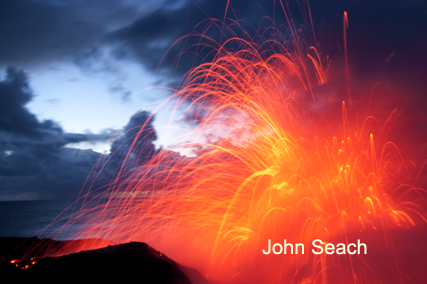
Littoral explosion, Kilauea volcano, Hawaii.
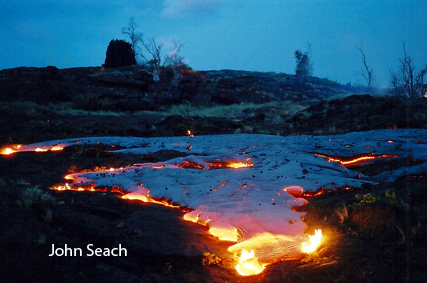
Surface Lava flows, Kilauea Volcano
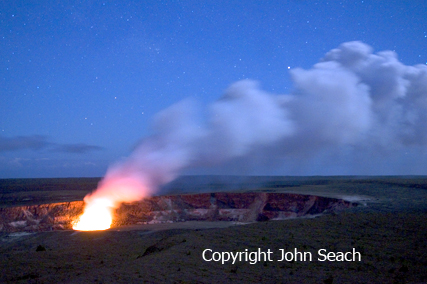
Kilauea summit crater glow, June 2009
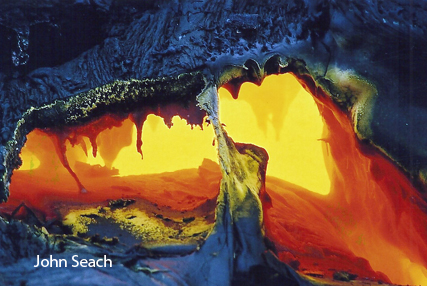
Skylight, Kilauea volcano, east rift zone
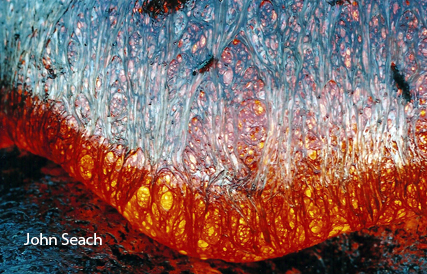
Lava flow closeup, Kilauea volcano, Hawaii
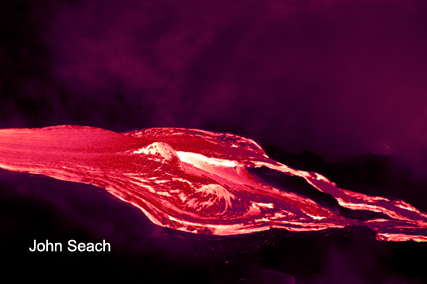
Kilauea lava flow
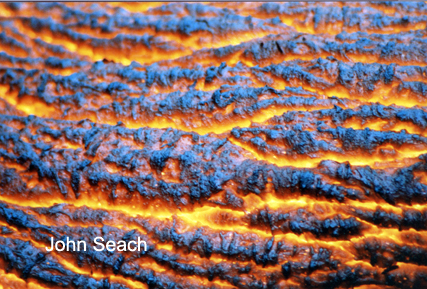
Lava flow Kilauea volcano, Hawaii

Kilauea lava ocean entry

Kilauea volcano lava flow
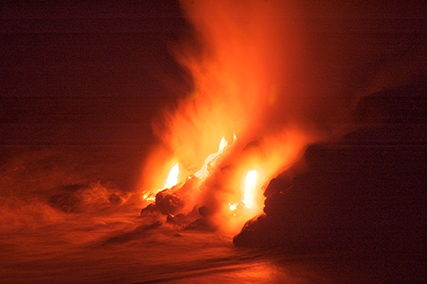
Kilauea volcano lava ocean entry 2005
2021-23 Eruption
Renewed activity began at Halamaumau crater on 05 Jan 2023. A lava flow was visible on the crater floor.
An eruption began in Halemaumau crater on September 29, 2021. New fissures produced lava flows on top of the previous lava lake surface. A new lava lake formed.
2020 Eruption
A summit eruption began in Halemaumau crater at 9:30 pm local time on 20 December 2020. The eruption was preceded by volcano inflation over the past month and earthquake swarms on 2 December. This was the first activity at the volcano since the large flank eruption in 2018.
2018 Eruptions
During March 2018, lava continues to flow into the sea at Kilauea
volcano. A small lava pond was visible in Pu'u 'O'o crater, and an
active lava lake continues in Halemaumau crater at the summit.
2015 Lava Lake activity
The lava lake in the Overlook crater at the summit of Kilauea
volcano, Hawaii overflowed on 28th April 2015. The lava spilled out
onto the floor of Halemaumau crater. Pahoehoe lava flowed 130 m
across the crater floor. The lava lake activity was accompanied by
rockfalls, explosions and ashfall at Jaggar museum overlook. A
perched lava lake has begun to form similar to lava lake activity
seen during 1800’s and 1900’s. Additional volcanic activity is
possible along the east rift zone between between Pauahi Crater and
Pu'u O'o.
5th November 2014 update
Lava from Kilauea volcano continues to flow towards Pahoa, Hawaii.
The flow front has temporarily stalled, but breakouts and inflation
are occurring 160 m upslope. This indicates lava is still flowing
through the system from Pu'u 'O'o crater. Residents in the lava flow
path have been advised of possible evacuation. Access to Pahoa
Village Road, between Apaa Street and the Post Office Road, is
limited to residents only. Highway 130 remains open, but may be
closed as lava approaches. Residents of Pahoa village heard methane
explosions.
January 2013 Update
January 3, 2013 marks the 30th anniversary of the beginning of the
current eruption at Kilauea volcano, Hawaii. This is a remarkable
eruption, and has been the longest eruption on the east rift zone in
recorded history. The eruption has been continuous for so long that
we have come to take it for granted. However the eruption will come
to an end sometime. Currently the volcano is erupting at the summit
and east rift zone. Lava continues to enter the ocean at several
locations.
October 2012 Update
Two lava lake are present at Kilauea volcano, Hawaii. The east pit
lava lake in Pu'u O'o crater occasionally flows across the floor of
the south pit. The summit lava lake in Halemaumau crater
occasionally overflows the inner ledge. The surface of the lava lake
varies from 60m to 150 m deep inside the pit. On the east rift zone
an active lava flow is located at the base of the pali in the
abandoned Royal Gardens subdivision. The lava contines to advance
towards the ocean. Sulphur dioxide emission was high at 1200 tonnes
per day on 28th September 2012.
2011 Fissure Eruption
A new fissure eruption has begun at Kilauea volcano in Hawaii on 5th
March 2011. The floor of Pu'u O'o crater collapsed over a period of
10 minutes. The event was preceded by a rapid deflation of Pu'u O'o
and increased tremor along Kilauea's middle east rift zone near
Makaopuhi and Napau craters. There was also deflation at the summit.
New fissure opened between Pu'u O'o and Napau crater. The fissure
ejected lava spatter 20 m high.
2009 Bench Collapse
A bench collapse occurred at Waikupanaha ocean
entry, Kilauea Volcano, Hawaii, on the afternoon of 17th February
2009 (local time). Four explosions were recorded between 12:45 and
1:15 pm. The lava delta and nearby areas remain dangerous and
should not be approached. Bench collapse can occur without
warning, and result in explosions and ejection of hot lava, and
local waves.
2008 Summit Eruption
An explosive eruption occurred on 19th March 2008, at Halema`uma`u
Crater at the summit of Kilauea Volcano in Hawaii. This was the
first explosive eruption in the summit crater since 1924. The
explosion occurred at the location of the new gas vent which formed
the week before. The eruption was probably phreatic, and created a
crater 30 m in diameter. Debris was thrown as far as Crater Rim
Drive near Halema`uma`u parking area 350 m away. Crater Rim Drive
has been closed recently due to high level of gas emission in the
area. The explosion occurred 3 miles from the town of Volcano with a
population of 2200.
Kilauea Volcano Safety
Hiking at Kilauea volcano is a demanding activity, and is best
pursued by those
who are physically fit, experienced in hiking, have suitable
clothes, enough water, and be informed about the risks.
Deflation-inflation events at Kilauea volcano in Hawaii are caused by changes in a secondary magma chamber east of Halemaumau Crater at about 750 m below ground level. This secondary magma chamber produces episodic deformation events.
Further reading
Neal, C.A., Brantley, S.R., Antolik, L., Babb, J.L., Burgess, M., Calles, K., Cappos, M., Chang, J.C., Conway, S., Desmither, L. and Dotray, P., 2019. The 2018 rift eruption and summit collapse of Kīlauea Volcano. Science, 363(6425), pp.367-374.
Cervelli, P.F. and Miklius, A., 2003. The shallow magmatic system of Kilauea Volcano. US Geol. Surv. Prof. Pap, 1676, pp.149-163.
Ingebritsen, S.E. and Scholl, M.A., 1993. The hydrogeology of Kilauea volcano. Geothermics, 22(4), pp.255-270.
Kilauea Volcano Eruptions
2021-23, 2020, 1983-2018, 1982, 1980, 1979, 1977, 1975, 1969-74, 1967-68, 1965,
1963, 1962, 1961, 1960, 1959, 1954, 1952, 1934, 1931-1932, 1930,
1929, 1927, 1906-24, 1905-06, 1903-04, 1902-03, 1897, 1896, 1823-94,
1820, 1790, 1750.
Earlier eruptions are not accurately dated.